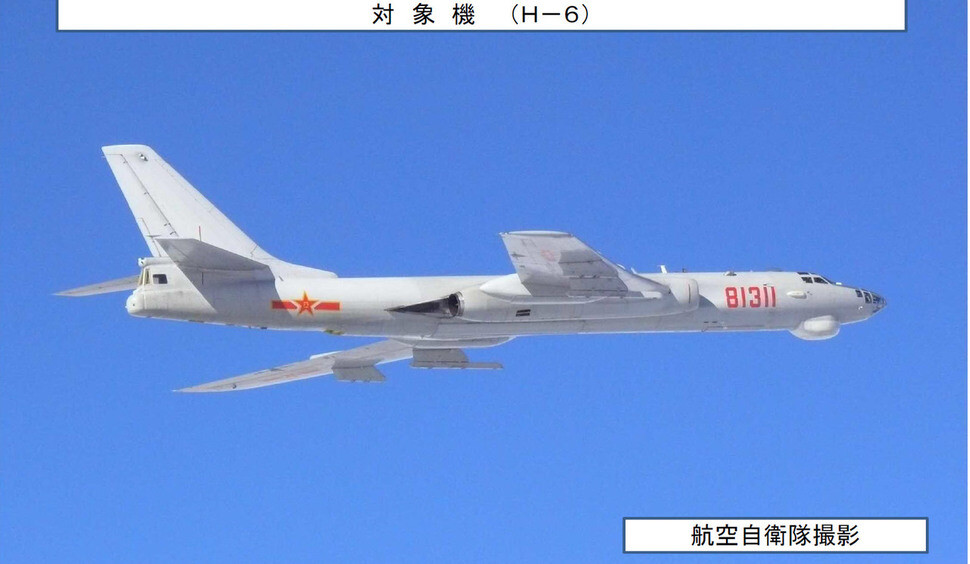hankyoreh
Links to other country sites 다른 나라 사이트 링크
In apparent show of force, China sends ten aircraft into S. Korean ADIZ

When asked about 10 Chinese military aircraft that entered the Korea Air Defense Identification Zone (KADIZ) near Ieo Island to the south of Jeju Island on Jan. 9, a senior South Korean military official admitted the “exceptional scale” of the flight but only said that the military was still trying to figure out China’s intentions. Analysts believe that the action was largely intended as a show of force, but they were divided about whether this show of force was only aimed at the US and Japan, or whether South Korea was included as a target.
“Last year, the Chinese military entered KADIZ on dozens of occasions, so this is nothing new or special,” said a senior official with South Korea’s Joint Chiefs of Staff during a press briefing on Jan. 10. The official emphasized that Chinese military aircraft had never entered sections of KADIZ where it does not overlap with Japan and China‘s air defense identification zones, and that this incident was no exception. The official said that “China had explained that it was conducting its own drills” and that South Korea and China “are not obligated to notify” each other when they enter the overlapping section of their air defense identification zones. The official did note that it was “rare” for 10 aircraft to enter the zone.
The explanation provided by South Korea’s Joint Chiefs of Staff and material made public by Japan‘s Defense Ministry indicate that ten or so Chinese military aircraft entered KADIZ from west of Ieo Island around 10 am on Jan. 9. Eight of these aircraft (six bombers, a reconnaissance plane and an early warning aircraft) flew through the Korea Strait south of Tsushima Island and into the East Sea before returning to the East China Sea. These eight aircraft passed through an area where South Korea, China and Japan’s air defense identification zone overlap and then flew through the Japan Air Defense Identification Zone (JADIZ).
During this process, the ROK Air Force launched an emergency sortie of around 10 fighters to observe and follow the Chinese aircraft, and the Japanese Self-Defense Forces also took the precaution of launching around 20 aircraft. South Korea’s Joint Chiefs of Staff reported that the Chinese military aircraft had completely left KADIZ around 3 pm on Jan. 9.
Justice Party lawmaker Kim Jong-dae, an expert in military affairs, described the action as “clearly designed for show.” “China was trying to send an emphatic message that it will defend its core interests, linking THAAD and the Senkaku Islands,” Kim said. Kim noted that China has been making maritime displays around the Senkaku Islands (known as the Diaoyu Islands in China), which are the subject of a territorial dispute between China and Japan, and that China is currently opposed to the deployment of the THAAD missile defense system with US troops in South Korea.
A different interpretation was offered by Kim Dong-yeop, a professor at the Institute for Far Eastern Studies at Kyungnam University and a former naval officer. “Considering that the aircraft flew north through Japan’s air defense identification zone, we should assume that China was targeting Japan. China is taking economic steps to exact retribution for the THAAD issue, but it’s too soon to conclude that they’re exacting military retribution as well,” Kim said.
An air defense identification zone is a unilaterally declared area that a country delineates to prevent other countries‘ aircraft from penetrating their airspace without authorization and to more quickly identify and receive early warnings about aircraft that would otherwise be unidentified. The concept differs from that of sovereign airspace, and the scope of jurisdiction is not recognized under international law.
By Kim Ji-eun, staff reporter
Please direct questions or comments to [english@hani.co.kr]

Editorial・opinion
![[Editorial] Does Yoon think the Korean public is wrong? [Editorial] Does Yoon think the Korean public is wrong?](https://flexible.img.hani.co.kr/flexible/normal/500/300/imgdb/original/2024/0417/8517133419684774.jpg) [Editorial] Does Yoon think the Korean public is wrong?
[Editorial] Does Yoon think the Korean public is wrong?![[Editorial] As it bolsters its alliance with US, Japan must be accountable for past [Editorial] As it bolsters its alliance with US, Japan must be accountable for past](https://flexible.img.hani.co.kr/flexible/normal/500/300/imgdb/original/2024/0417/6817133413968321.jpg) [Editorial] As it bolsters its alliance with US, Japan must be accountable for past
[Editorial] As it bolsters its alliance with US, Japan must be accountable for past- [Guest essay] Amending the Constitution is Yoon’s key to leaving office in public’s good graces
- [Editorial] 10 years on, lessons of Sewol tragedy must never be forgotten
- [Column] A death blow to Korea’s prosecutor politics
- [Correspondent’s column] The US and the end of Japanese pacifism
- [Guest essay] How Korea turned its trainee doctors into monsters
- [Guest essay] As someone who helped forge Seoul-Moscow ties, their status today troubles me
- [Editorial] Koreans sent a loud and clear message to Yoon
- [Column] In Korea’s midterm elections, it’s time for accountability
Most viewed articles
- 1[Column] The clock is ticking for Korea’s first lady
- 2Samsung barricades office as unionized workers strike for better conditions
- 3[Editorial] When the choice is kids or career, Korea will never overcome birth rate woes
- 4Why Israel isn’t hitting Iran with immediate retaliation
- 5[News analysis] After elections, prosecutorial reform will likely make legislative agenda
- 6[Editorial] Does Yoon think the Korean public is wrong?
- 7S. Korea, Japan reaffirm commitment to strengthening trilateral ties with US
- 8[Editorial] As it bolsters its alliance with US, Japan must be accountable for past
- 9Japan officially says compensation of Korean forced laborers isn’t its responsibility
- 10Faith in the power of memory: Why these teens carry yellow ribbons for Sewol